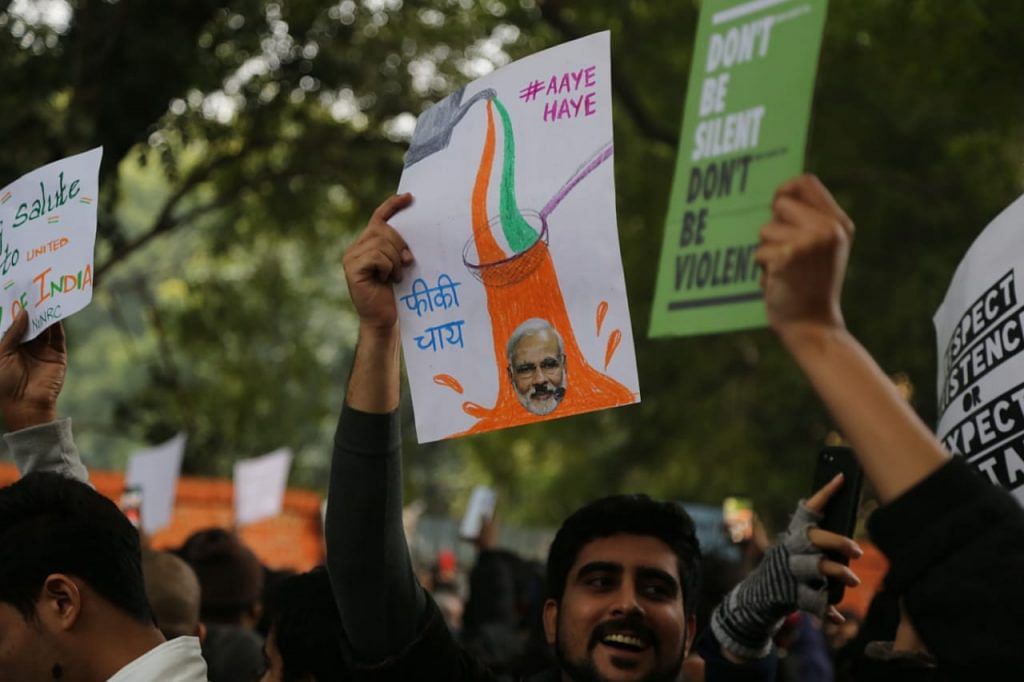If there’s anything we Indians should thank the Narendra Modi government for, it is the proliferation of art, poetry and creative content during its regime. Not that Modi and Amit Shah have helped with patronage. But the bulldozing of controversial bills through Parliament has made many critics of the Modi-Shah government express their dissent rather creatively – since saying it directly has landed many in jail.
The Citizenship Amendment Act (CAA) and National Register of Citizens (NRC) have been the recent catalysts for this creativity among Indians. Every street corner, there is comedy, poetry, memes, art, sloganeering and quirky posters.
From placards that ask India not to turn into a low-budget Israel to artwork that say “we’ll fight, but with love”, Indians have stumped the Modi government and its propaganda machinery with a messaging that’s hard to take legal action against. And yet, it is proving to be very effective.
I call this moment India’s renaissance.
Also read: Modi’s India unhappy with protesters singing Faiz’s Hum Dekhenge. Zia’s Pakistan was too
A shift
The European Renaissance in the 14th-17th century was marked by modernisation of art, architecture, philosophy, science and politics. It was a shift from the Middle Ages to a Modern Age that focused on humanism and realism.
In India today, we are seeing a renaissance through art and literature – people are getting their voice back. And what is aiding it is the social media coverage of the protests. Art has always been a medium of dissent – but now, a lot of people are getting exposure to it, thanks to Twitter, Facebook, Instagram and WhatsApp.
Pictures have a higher tendency to go viral. So, when a German student holds up a poster in an anti-CAA protest saying “1933-45, we’ve been there”, it is bound to make a statement. Anyone with a rudimentary knowledge of history would know that the poster is a reference to the Nazi era when Jews were brutally persecuted by Adolf Hitler. The student, Jakob Lindenthal, was sent back to Germany. The Ministry of External Affairs, however, denied forcing him out, saying he was going home for Christmas anyway.
I spoke to Avani Chokshi from Bangalore, member of a collective called Hum Bharat Ke Log and part of the nationwide strike on 19 December against CAA, about why are people turning to art in these protests. She said that to curb the protests and after imposition of Section 144 in Bangalore, hundreds of protestors were put in an enclosed hall where they turned to poetry and shayari. It unites people.
Another protester from Kolkata, Kamran Ahmed Khan, who made masks for anti-CAA protesters, told me that he turned to art because he felt he “was representing the Netflix and Amazon crowd, basically young people who usually don’t care about daily politics and want to stay away from the mess happening around”. “So, I decided to have these Dali masks made, which were used in the Netflix show Money Heist. Dali masks are a sign of resistance. I wanted to send a message that we the young people of India would resist this ridiculous and highly communal and divisive law,” said Khan.
Tribal people also joined the protests, especially against the NRC, which asks for citizenship proof.
And then there are the senior citizens from Delhi’s Shaheen Bagh who recited Varun Grover’s ‘Hum Kaagaz Nahi Dikhayenge’. They have been sitting in protest for days through the cold winter.
Hindus are dressing as Muslims by wearing hijabs and skull caps, while Muslims are donning tilaks and turbans to show that Prime Minister Modi’s barb of protesters being easily identified by their clothes has no basis in reality. As I wrote before, it isn’t a Muslim-only protest, it’s an everyone, everywhere protest. Indians are turning away from the delusion of WhatsApp University. Indian renaissance indeed.
Also read: The placards and songs that ruled the CAA protests across India
‘Hindustani Musalmaan’
Muslims also got their mojo back in these protests. From holding up posters saying “Miya bhai ek dawat na chore mulk kya ghanta chorega” (Muslims don’t give up a dinner party, and you expect them to leave their country) to being unapologetic about their clothes, identity and their overall “Muslimness”, these protests are addressing that awkward question that the Right-wing harangues Muslims with – “How ‘Indian’ are Muslims?”
Hussain Haidry questioning “main kaisa Musalmaan hoon? (What kind of a Muslim am I?)” through a poem he wrote, to a crowd in Azad Maidan, hits at the heart of the matter. Every Muslim is questioning their identity in this nation today. And the answer is in Haidry’s poem – “a Hindustani Musalmaan.”
Got the full video of my poem’s performance today at Azad Maidan, for Inqalaab Morcha.
Kaafi ghazab log jo wahaan aaye, hazaar shukriya. pic.twitter.com/I9Sq1hBZz0
— Hussain Haidry | حسین حیدری (@hussainhaidry) December 27, 2019
Also read: In 2020, don’t rely on routine rallies and marches. Modi’s India needs new ways to protest
Popular content floating on the internet, WhatsApp and print media shows the words ‘tyranny’ and ‘fascism’ now being associated with Narendra Modi and Amit Shah – and obviously, the art and literature had a part to play in this association. The content being produced in these protests are predominantly using these words as adjectives for the ruling duo.
Art has truly made people expand and push the boundaries of conversation.
The anti-CAA-NRC protests are no longer just about Muslim “intelligentsia”. These protests are not in the news because of a Naseeruddin Shah, Javed Akhtar, Shabnam Hashmi or Shehla Rashid. They are in the news because Indians have taken to the streets to sing, chant, paint against it.
The author is a political observer and writer. Views are personal.
